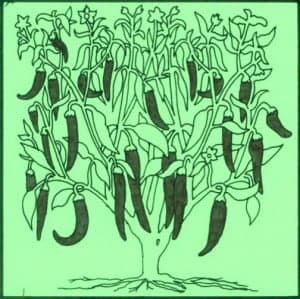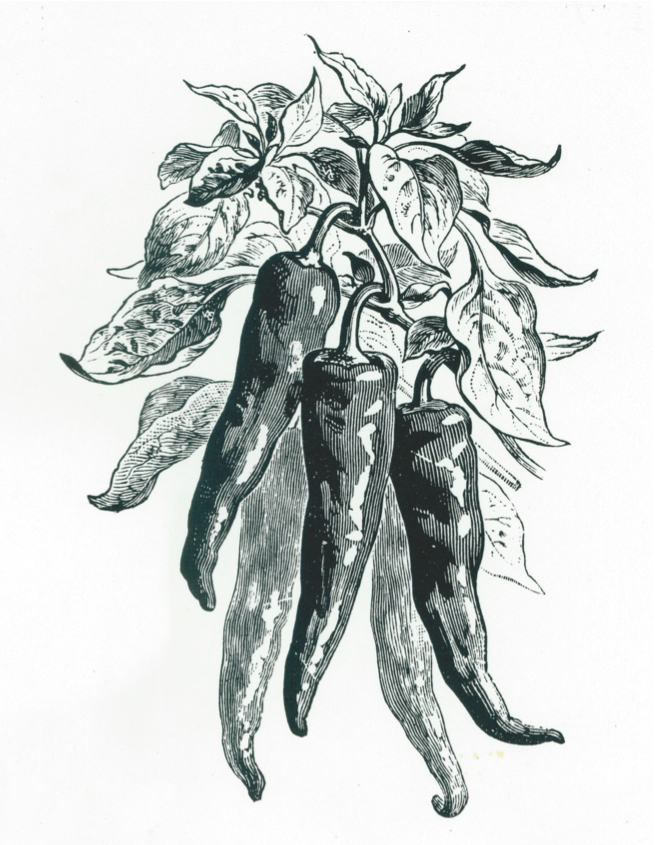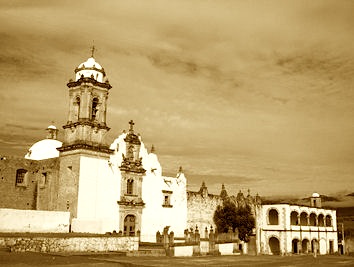By Dave DeWitt
Chile is so ingrained into the culture of Mexico that chile expert Arturo Lomelí wrote: “Chile, they say, is the king, the soul of the Mexicans—a nutrient, a medicine, a drug, a comfort. For many Mexicans, if it were not for the existence of chile, their national identity would begin to disappear.”
Early Origins
In southern Mexico and the Yucatán Peninsula, chile peppers have been part of the human diet since about 7500 B.C. and thus their usage pre-dates the two great Central American civilizations, the Mayas and the Aztecs. From their original usage as a spice collected in the wild, chiles gained importance after their domestication and they were a significant food when the Olmec culture was developing, around 1000 B.C.
About 500 B.C., the Monte Albán culture, in the Valley of Oaxaca, began exporting a new type of pottery vessel to nearby regions. These vessels resembled the hand-held molcajete mortars of today and were called Suchilquitongo bowls. Because the molcajetes are used to crush chile pods and make salsas today, the Suchilquitongo bowls are probably the first evidence we have for the creation of crushed chile and chile powders. Scientists speculate that chile powder was developed soon after the Suchilquitongo bowls were invented, and both the tool and the product were then exported.
A carved glyph found in the ceremonial center of Monte Albán is further evidence of the early importance of chile peppers. It features a chile plant with three pendant pods on one end and the head of a man on the other. Some experts believe that the glyph is one of a number of “tablets of conquest” which marked the sites conquered by the Monte Albán culture.
The Spicy Legacy of the Maya
When the Europeans arrived in the Western Hemisphere, people of Mayan ancestry lived in southern Mexico, the Yucatán Peninsula, Belize, Guatemala, and parts of Honduras and El Salvador. The Mayan civilization had long passed its height by that time, so there are no European observations about their classic culture. All that exist today are writings about their descendants; Mayan hieroglyphics, which are slowly being transliterated; and ethnological observations of the present Maya Indians, whose food habits have changed little in twenty centuries.
By the time the Mayas reached the peak of their civilization in southern Mexico and the Yucatán Peninsula, around A.D. 500, they had a highly developed system of agriculture. Maize was their most important crop, followed closely by beans, squash, chiles, and cacao. Perhaps as many as thirty different varieties of chiles were cultivated, and they were sometimes planted in plots by themselves but more often in fields already containing tomatoes and sweet potatoes. There were three species of chiles grown by the Maya and their descendants in Central America: Capsicum annuum, Capsicum chinense, and Capsicum frutescens–and they were all imports from other regions. The annuums probably originated in Mexico, while the frutescens came from Panama, and the chinense from the Amazon Basin via the Caribbean. The Mayas also cultivated cotton, papayas, vanilla beans, cacao, manioc, and agave.
The importance of chiles is immediately seen in the most basic Mayan foods. According to food historian Sophie Coe, “The beans…could be cooked in plain water or water in which toasted or untoasted chiles had been steeped. Such a chile ’stock’ might be called the basis of the cuisine, so frequently does it turn up. It is in everything from the tortilla accompaniment of the very poorest peasant to the liquid for cooking the turkey for the greatest celebrations. There is even a reference to it in the [Maya sacred text], the Popul Vuh, where the grandmother grinds chiles and mixes them with broth, and the broth acts as a mirror in which the rat on the rafters is reflected for the hero twins to see.”
Coe speculates that the first sauces were used for tortilla-dipping. “The simplest sauce was ground dried chiles and water,” she writes in America’s First Cuisines. “From this humble ancestor comes the line which terminates with trendy salsas beloved of a certain school of today’s chefs.” The ground or crushed chiles–sometimes in a thick sauce– were used to preserve and prolong the life of a piece of meat, fish, or other game. Since there was no refrigeration, fresh meat spoiled quickly, and by trial and error, the earliest cooks realized that chiles were an antioxidant, preserving the meats to some degree.
“But even the original inventors of tortilla-dipping sauces varied them when they could,” Coe added. “The ground toasted seeds of large and small squashes, always carefully differentiated by the Maya, could be added to the basic chile water, or you could mix epazote with the water and then add ground, toasted squash seeds to the flavored liquid.” As more and more ingredients were added, a unique family of sauces was developed that led to the pipiáns and moles of today.
For breakfast the Maya ate a gruel of ground maize spiced with chile peppers, which is usually called atole but is sometimes known as pozól. A modern equivalent would be cornmeal or masa mixed with water and ground red chiles to the consistency of a milkshake. A favorite drink was chocolate mixed with water, honey, and chile powder.
For the main, or evening meal, stews of vegetables and meats heavily spiced with chiles were served. One of these was chacmole, which combined venison with chile, achiote, allspice, and tomato–it was an offering to the gods as well as a nourishing entree. Various reports describe sauces made with chiles and black beans being wrapped in corn tortillas and covered with chile sauce, which may be the earliest references to enchiladas. As Sophie Coe noted, “The accepted wisdom was that tortillas and beans were boring; it took chile to make the saliva flow.”
The Maya seem to have invented tamales too, as the Spanish chronicler Gonzalo Fernández de Oviedo reported in 1526: “They brought certain well made baskets, one with the pasticci [filled pies] of maize dough stuffed with chopped meat…. They ate it all, and praised that dish pasticci, which tasted as if it were spiced. It was reddish inside, with a good quantity of that pepper of the Indies which is called asci [the Antillean word for chile, modernized to ají].” Mayan tamales were quite sophisticated, with many different fillings, including toasted squash seeds, deer hearts, quail, egg yolks, dove breasts, squash blossoms, and black beans. The Maya kept domesticated turkeys, ducks, bees, and dogs, and their main game animals were deer, birds, iguana, and wild boar. Armadillos and manatees were considered delicacies. As with the Inca, meat dishes were reserved for Mayan royalty.
Chiles are highly visible today in areas with a Mayan heritage. In the Yucatán Peninsula, descendants of the Maya still grow habaneros, tomatoes, and onions in boxes or hollowed-out tree trunks that are raised up on four posts for protection against pigs and hens. These container gardens are usually in the yard of the house, near the kitchen.









